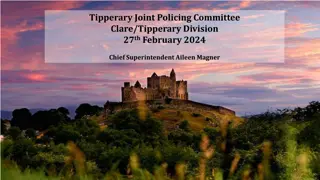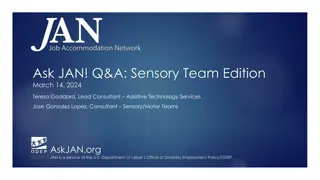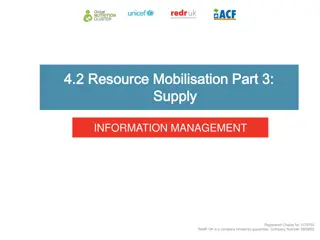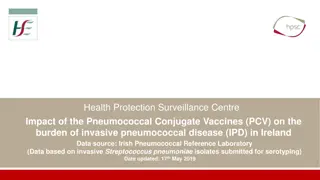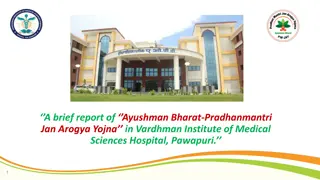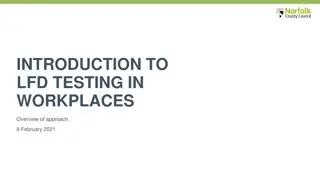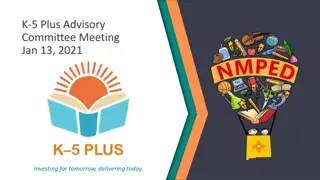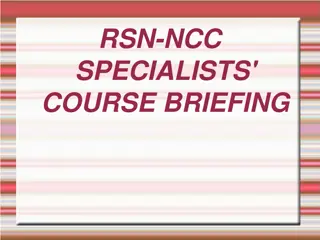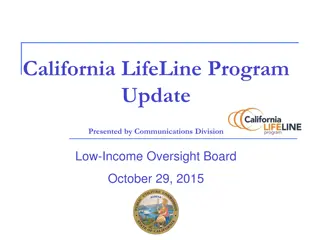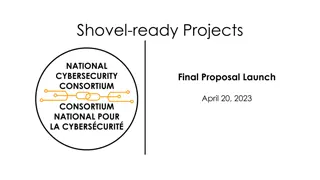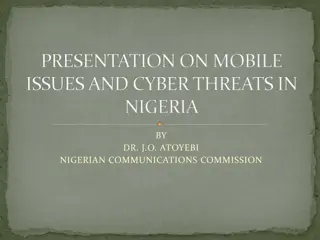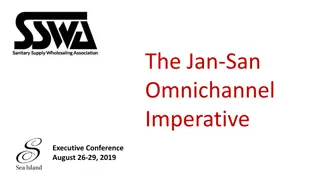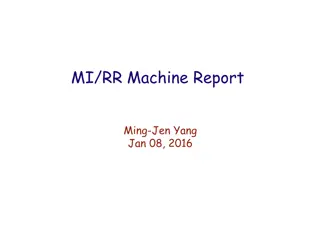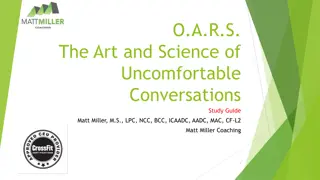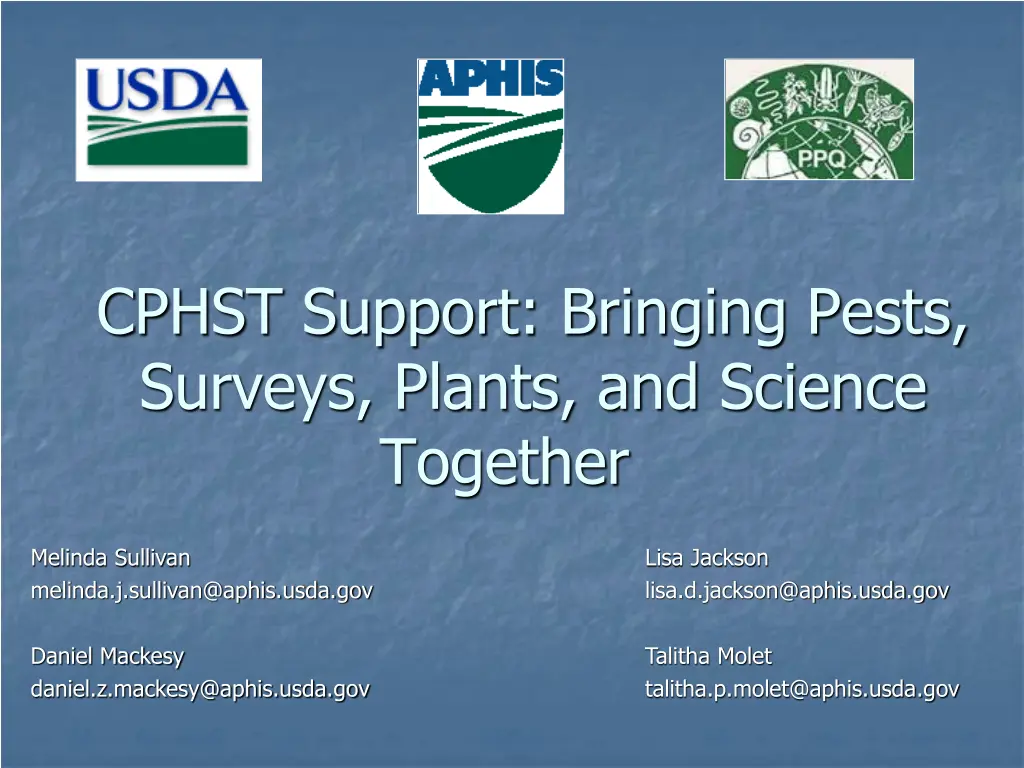
Bringing Pests, Surveys, and Science Together: CPHST Support Updates
Explore how the CPHST Support is revolutionizing its manual format to enhance the accessibility and efficiency of pest surveys through individual pest datasheets instead of bulky documents. By streamlining their approach, they aim to provide better support for pest control efforts and scientific research.
Download Presentation

Please find below an Image/Link to download the presentation.
The content on the website is provided AS IS for your information and personal use only. It may not be sold, licensed, or shared on other websites without obtaining consent from the author. If you encounter any issues during the download, it is possible that the publisher has removed the file from their server.
You are allowed to download the files provided on this website for personal or commercial use, subject to the condition that they are used lawfully. All files are the property of their respective owners.
The content on the website is provided AS IS for your information and personal use only. It may not be sold, licensed, or shared on other websites without obtaining consent from the author.
E N D
Presentation Transcript
CPHST Support: Bringing Pests, Surveys, Plants, and Science Together Melinda Sullivan melinda.j.sullivan@aphis.usda.gov Lisa Jackson lisa.d.jackson@aphis.usda.gov Daniel Mackesy daniel.z.mackesy@aphis.usda.gov Talitha Molet talitha.p.molet@aphis.usda.gov
Topics Format New Surveys/Manuals for 2016 Proposed New Process for Manuals Possible New Manuals Manual Changes
Manual Format In the past, each manual was offered as one large PDF file. Two separate documents were available: Reference All pest datasheets in one file Guidelines Contained survey planning information Issues: Documents large took too long to download and pull out pieces relevant to each state-specific survey Guidelines document too complicated state budgets/ resources often do not allow statistically significant levels of survey Updating documents was difficult/ time-consuming for CPHST support staff
Manual Format We are now offering each manual as a standalone Introduction and providing links to individual pest datasheets. Introduction: General survey information will replace Guidelines document The new format allows CPHST to make one datasheet for each pest, link it where appropriate, and eliminate the need for duplicate updates. Spodoptera littoralis 6 different manuals and on AHP listing
Manual Format The current manuals in the new format include: Asian Defoliator, Cyst Nematode, Exotic Wood Boring/ Bark Beetle, Grape, Mollusk, Palm, and Solanaceous Hosts. New manuals are produced using the new format. All of the older manuals will be updated and offered in this format. Will work on the older manuals in order of use/ popularity of survey. Aiming to complete at least one manual update (with complete datasheet revision) each year. CPHST CAPS support recently finished putting Grape into the new format. Stone Fruit will be the next manual updated.
Listing of Currently Available Manuals Commodity-Based Corn CAPS Cotton CAPS Grape FB Oak CAPS Palm FB Pine CAPS Small Grains (wheat, oats, rye, barley) CAPS Soybean CAPS Solanaceous Hosts FB (eggplant, tomato, potato, pepper, tobacco) Stone Fruit FB (peach, plum, nectarine, cherry) Taxon-Based Asian-Defoliator FB Cyst Nematode FB/CAPS Exotic Wood Borer/Bark Beetle FB/CAPS Mollusk FB/CAPS
New Surveys/ Manuals 2016
Tropical Pests Intended to provide American Samoa, Guam, Hawaii, Puerto Rico, & U.S. Virgin Islands with their own pest list due to their unique climate and crop species. Criteria (because ranking model not available): 1. Had to have at least 2 regions interested in conducting a survey for the pest (polled the states/territories via PSSs) Region 1: Puerto Rico/U.S. Virgin Islands Region 2: Hawaii Region 3: American Samoa Region 4: Guam 2. Not widely distributed already 3. Pass pre-assessment (pathway present into at least Hawaii or Puerto Rico; harder to assess for other areas) 4. Pass post-assessment (survey and identification methods available)
Tropical Pest Suggestions 13 Arthropods Scientific Name Common Name Type of Pest Source Aspidiotus rigidus Armored scale Scale insect PestLens Conogethes punctiferalis Castor capsule borer Moth Additional Pests of Concern Ecdytolopha aurantiana (Gymnandrosoma aurantianum) Macadamia nutborer, citrus fruit borer Moth Additional Pests of Concern OPIS B, of interest to PPQ trade director Heilipus lauri Avocado seed weevil Weevil Homalodisca vitripennis Glassy winged sharpshooter Planthopper/Leafhopper Submitted by Guam Hypocryphalus mangiferae Mango bark beetle Beetle PestLens Palmicultor lumpurensis Bamboo mealybug Mealybug Submitted by Guam Paratachardina pseudolobata Lobate lac scale Scale insect Submitted by Guam Scirtothrips dorsalis Chilli thrips Thrips Submitted by Guam Stenoma catenifer Avocado seed moth Moth Additional Pests of Concern Sternochetus mangiferae Mango seed weevil Weevil Additional Pests of Concern Tetranychus kanzawai Kanzawa spider mite Mite Submitted by Guam Submitted by Puerto Rico/USVI Xyleborus glabratus* Redbay ambrosia beetle Beetle * Already a prioritized pest (EWB/BB manual)
Tropical Pest Suggestions 13 Plant Pathogens Scientific Name Common Name Type of Pest Source Babuvirus Banana bunchy top virus Badnavirus Banana streak virus Badnavirus Taro bacilliform virus Banana bunchy top virus Virus Additional Pests of Concern Banana streak virus Virus Submitted by Am. Samoa Taro bacilliform virus Virus Additional Pests of Concern Ceratocystis manginecans Mango sudden fungus decline Fungus PestLens Fusarium oxysporum f. sp. cubense TR4 Panama Disease Tropical race 4: Submitted by Puerto Rico State Survey Coordinator Fungus Neofusicoccum mangiferae Fruit rot of mango Fungus PestLens Nucleorhabdovirus Colocasia bobone disease virus Nucleorhabdovirus Taro vein chlorosis virus Potyvirus Blackeye cowpea mosaic virus - a distinct strain of Bean common mosaic virus Potyvirus Zucchini yellow mosaic virus Submitted by Am. Samoa; Additional Pests of Concern Colocasia bobone disease Fungus Submitted by Am. Samoa; recent find in Hawaii (NPAG) Taro vein chlorosis Virus Blackeye cowpea mosaic/bean common mosaic, cowpea strain Virus Submitted by Am. Samoa Zucchini yellow mosaic Virus Submitted by Am. Samoa Submitted by Puerto Rico/USVI Raffaelea lauricola Laurel wilt Fungus Tospovirus Capsicum chlorosis virus Xanthomonas campestris pv. musacearum Capsicum chlorosis virus Virus Submitted by Am. Samoa Banana Xanthomonas Wilt Bacterium Additional Pests of Concern
Tropical Pest Suggestions Criteria # of Arthropods failed # of Plant Pathogens failed 1 - Pest already on CAPS Priority list 1 2 Minimum # of regions 2 2 Distribution 2 4 Pre-assessment (Pathway) 2 - Pre-assessment (Non-reportable) 1 3 Post-assessment Total Failed 9 11 # Left 4 2
Current Tropical Pest List Scientific Name Common Name Aspidiotus rigidus none, an armored scale Ceratocystis manginecans* Mango sudden fungus decline Conogethes punctiferalis Castor capsule borer Fusarium oxysporum f. sp. cubense TR4 Panama Disease Tropical race 4 Gymnandrosoma aurantianum Macadamia nutborer Paratachardina pseudolobata Lobate lac scale * Vector discussion
New Surveys Anticipated for 2016 Tropical Pest Manual Working on finalizing the pest list for the manual May need to solicit a few more new pests Once the list is finalized, work will begin on the datasheets and Introduction We will make datasheets available as completed but all will be completed no later than August 2015.
Proposed New Process for Manuals
Proposed Process for New Manuals In the future, manual suggestions will require a champion to sponsor it. The champion will be required to submit an initial pest list (at least 6 exotic species) for consideration. At least 4 or 5 states will need to sign up/ express interest for the new survey before development occurs.
Champion Responsibilities 1. Reach out to other states for their interest in survey (via PSSs, SSCs, SPHDs, SPROs) 2. Provide CPHST with a list of states who would be interested in participating. 3. Reach out to university extension for exotic pests of concern (6 pests per manual is the minimum to constitute a new manual). 4. Reach out to industry for exotic pests of concern? Is this feasible? Who should do this (PPQ or champion)? 5. Could add a few pests of limited distribution or pests limited to one region of the country but not other areas important to the commodity.
New Surveys Anticipated for 2017 1. Apple and Pear Commodity Manual Beginning to work on the Pest list 1. Want to get manual champions involved One from east (Rachel Braud -WV) & want a champion from the west 2. Have a pest list related to trade with the European Union to start with. 31 pests in total (19 of which are not on our prioritized pest list or already present) 3. Industry input? Datasheets and Introduction to come after pest list finalized Working on this manual while updating Stone Fruit manual (overlap of pests with apple/pear; pests can go into manual where make the most impact).
Other Suggested Surveys 1. Berries/Small Fruit Saul Vaiciunas is the current champion Has sent us 3 or 4 possible pests that we are evaluating Likely 2018 at earliest 2. Dry bean/ pea/ pulse crops Ian Foley (MT) is willing to champion per Helmuth 3. Vegetable seed Nancy Osterbaur (OR) and Helmuth Rogg are willing to champion per Helmuth Want to focus on viruses concern is ID methods
Manual/Datasheet Revisions Changes to datasheets and manuals occur on a yearly basis. If substantial changes are made, a new version is created. New survey or ID method Pest addition/ removal Changes are listed in the draft log at the beginning of each manual. Datasheet changes are also at the end of the specific datasheet. CAPS Approved methods and forum email notices (CR&C site). Starting to apply pre- and post-assessment filters to commodity manuals as well.
Changes to Manuals for 2015/2016 2015 Grape Removed*: Adoxophyes orana (summer fruit tortrix moth) (minor host for this moth; not likely to be detected in grape). Removed*: Diabrotica speciosa (cucurbit beetle) (minor host for this beetle; not likely to be detected in grape). * Note: Pests are available in other manuals and can be bundled. Updated all datasheets and put into new format (standalone datasheets and introduction document). 2016 Grape Adding: Lycorma delicatula (spotted lanternfly) Several states are interested in this pest after PA find. Adding: Brevipalpus chilensis (Chilean false red mite) PPQ P&M/ PDMT request; survey needed; fumigation costs for this pest in grape.
Changes to Manuals for 2015/2016 2016 Soybean Removing: Adoxophyes orana (summer fruit tortrix moth) (minor host for this moth; not likely to be detected in soybean). Removing: Heteronychus arator (black maize beetle) (minor host for this beetle; not likely to be detected in soybean) 2016 Oak Removing: Ephiphyas postvittana (light brown apple moth/LBAM) (minor host for this moth; not likely to be detected in oak)
Changes to Manuals for 2015/2016 2016 Small Grains Removing: Lobesia botrana (European grapevine moth) Barley likely not a host Removing: Peronosclerospora philippensis (Philippine downy mildew) Oats only minor host; not likely to be detected in oats. Removing: Spodoptera litura (cotton cutworm) Wheat only minor host; not likely to be detected in oats. Removing: Heteronychus arator (black maize beetle) (minor host for this beetle; not likely to be detected in small grains)
Potential Changes to Manuals for 2015/2016 Two new pathogens Candidatus Phytoplasma solani (bois noir; stolbur phytoplasma) Very broad host range; rapidly spreading across Europe Likely will add this pest to grape, Solanaceous hosts, corn, and stone fruit Phytophtora kernoviae (No common name) Very similar to P. ramorum (similar host range plus beech) May add to oak manual
Discussion CPHST can only maintain manuals and pest lists at current levels (10 manuals; ~145 pests in total) with current staffing 1. Is there agreement with the champion idea? Puts some responsibility on the manual suggestor/ champion vs. just CPHST. 2. Can we have too manual manuals? Are we spreading our resources too thin; only certain amount of funding available? 3. How to prioritize new manual suggestions?
One Option: Manual Rotation CPHST plans to clean up existing/older manuals as we update them; remove pests that are not being surveyed for or are only minor hosts of a given host. Manual rotation may be an option (sometime in the future). Manuals available for survey could be rotated (available some years; not available other years) CAPS and Farm Bill need to implement to be effective How do we do this and still meet the needs of the field? Rotate by popularity of survey. Less popular not available first. Rotate yearly (may not work as some states do the same survey across multiple years/ split state into smaller units, survey for a subset of pests of interest across years, etc.) Survey available for 2-3 years and then rotated (not available) for several years.


